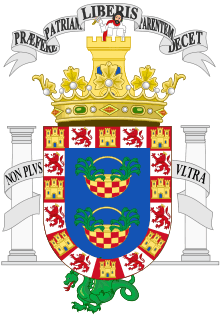Siege of Melilla (1774)
The Siege of Melilla was an attempt by the British-backed[2] Sultanate of Morocco to capture the Spanish fortress of Melilla on the Moroccan Mediterranean coast. Mohammed ben Abdallah, then Sultan of Morocco, invested Melilla in December 1774 with a large army of Royal Moroccan soldiers and Algerian mercenaries. The city was defended by a small garrison under Irish-born Governor Don Juan Sherlocke until the siege was lifted by a relief fleet in March 1775.
| Siege of Melilla | |||||||
|---|---|---|---|---|---|---|---|
| Part of Hispano-Moroccan wars | |||||||
 Engraving of the Siege, 1774. | |||||||
| |||||||
| Belligerents | |||||||
|
|
Supported by: | ||||||
| Commanders and leaders | |||||||
|
|
| ||||||
| Strength | |||||||
| 5,000[1] | 40,000[1] | ||||||
| Casualties and losses | |||||||
| 600 dead or wounded[1] | |||||||
Battle
With the promise of British subsidies[3] and material aid for a war against Spain, Mohammed ben Abdallah assembled an army of 40,000 men and powerful artillery in 1774 and began a bombardment of Melilla.[1] Spanish troops resisted the attack over a period of 100 days, over which time some 12,000 projectiles were lobbed onto the city.[1] A small garrison under Florencio Moreno likewise resisted the Sultan's army at Peñón de Vélez de la Gomera.
In 1775 war material from England en route to Melilla was intercepted and captured by the Spanish Navy and Spanish sail approached the beleaguered city; at the same time the Turks began to encroach on Morocco's eastern borders.[1] Sherlocke began to break the siege, a situation exacerbated by the desertion of ben Abdallah's Algerians. Melilla was relieved in March. The end of the siege is still commemorated as Nuestra Señora de la Victoria, "Our Lady of Victory."
With the Peace of Aranjuez in 1780, Morocco recognized Spanish rule of Melilla.
Notes
- Rezette, p. 42
- Rezette 1976, pp. 42–47
- Rezette 1976, pp. 42–44
References
- Rezette, Robert (1976). The Spanish Enclaves in Morocco. Nouvelles Editions Latines Publishing.
